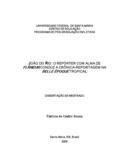| dc.creator | Sousa, Patrícia de Castro | |
| dc.date.accessioned | 2009-08-27 | |
| dc.date.available | 2009-08-27 | |
| dc.date.issued | 2009-06-17 | |
| dc.identifier.citation | SOUSA, Patrícia de Castro. João do Rio: the flâneur nature reporter conducts "chronicle-reportage" in tropical Belle Époque. 2009. 100 f. Dissertação (Mestrado em Letras) - Universidade Federal de Santa Maria, Santa Maria, 2009. | por |
| dc.identifier.uri | http://repositorio.ufsm.br/handle/1/9806 | |
| dc.description.abstract | The research has as its main object parts of João do Rio s writings found in A Alma Encantadora das Ruas (1908). The goal of the research and dissertation herein presented is to investigate the style present in these texts, intending to demonstrate that they represent a interwining transition between a strict literature contribution to a
specific jounalistic text: João do Rio would had established the bridge to contemporaneous journalistic writings. The research approach consists in the
analysis and classification of selected texts the
object under investigation usualy qualified as chronicles by literature experts. However, the relevance of a remarkable journalistic style is found in João do Rio s writings. The chapters of this dissertation add on each other leading to place his writings in the cathegory of chroniclereportage, the concept that motivated the research developed. The investigation encompasses: the writer biography and the background literature influencing him; the historical, social and economical context existing during the first decade of the 20th century, a period during which had appeared a number of writings that contributed to the framing of the interwining components of the journalistic and the literature styles. The flânerie incorporated by João do Rio in his texts and the outcomes of this practice on his writings are analysed in the present dissertation. Furthermore, comments on the stilistics were added demonstrating that the flanêur was not present in the environment he described. The evolution and definitions related to chronicle and reportage are addressed as demanded by the the coexistence of both
styles in João do Rio s writings. In addition, the contextual and conceptual components described are step by step followed by a detailed analisys of the investigated object. | eng |
| dc.format | application/pdf | por |
| dc.language | por | por |
| dc.publisher | Universidade Federal de Santa Maria | por |
| dc.rights | Acesso Aberto | por |
| dc.subject | João do Rio | por |
| dc.subject | Literatura | por |
| dc.subject | Jornalismo | por |
| dc.subject | História | por |
| dc.subject | Literature | eng |
| dc.subject | Journalism | eng |
| dc.subject | History | eng |
| dc.title | João do Rio: o repórter com alma de flâneur conduz a
crônica-reportagem na Belle Époque tropical | por |
| dc.title.alternative | João do Rio: the flâneur nature reporter conducts "chronicle-reportage" in tropical Belle Époque | eng |
| dc.type | Dissertação | por |
| dc.description.resumo | A pesquisa João do Rio: o repórter com alma de flâneur conduz a crônicareportagem na Belle Époque tropical tem como objeto alguns escritos que integram a obra A Alma Encantadora das Ruas (1908), de João do Rio. O objetivo do
trabalho é discorrer sobre a problemática do gênero que envolve esses textos, visando demonstrar que se situam numa posição intermediária, de transição, entre as colaborações estritamente literárias e as especificamente jornalísticas, sendo João do Rio a ponte para o estabelecimento da reportagem contemporânea. A pesquisa se baseia na análise e classificação dos textos que compõem o objeto, os quais, usualmente, são categorizados como crônicas pelos críticos literários. É notória, entretanto, a relevância do discurso jornalístico nos textos de João do Rio.
Os capítulos deste estudo acabam então por convergir no sentido de inserir os escritos na categoria de crônicareportagem, conceito que move esta pesquisa. O
trabalho abarca, primeiramente, a biografia do escritor e suas influências literárias. A pesquisa perpassa o contexto histórico, social e econômico da primeira década do
século vinte, período que contribuiu para a tessitura de textos que mesclam elementos literários e jornalísticos. A flânerie a que adere João do Rio e o desdobramento dessa prática na sua escrita são aqui analisadas. Ao mesmo tempo são feitas algumas considerações estilísticas que asseveram o não pertencimento do flanêur ao espaço que retrata. A evolução e definições da crônica e da reportagem são desenvolvidos no trabalho pelo fato dos textos de João do Rio estarem inseridos numa categoria que conjuga ambos os gêneros: a crônicareportagem. Além dos elementos contextuais e conceituais, o estudo é entremeado por análises detalhadas do objeto. | por |
| dc.contributor.advisor1 | Pereira, Lawrence Flores | |
| dc.contributor.advisor1Lattes | http://lattes.cnpq.br/2329033954605102 | por |
| dc.contributor.referee1 | Vieira, Andre Soares | |
| dc.contributor.referee1Lattes | http://lattes.cnpq.br/9443094274110873 | por |
| dc.contributor.referee2 | Tosta, Sandra de Fátima Pereira | |
| dc.contributor.referee2Lattes | http://lattes.cnpq.br/8005896521093222 | por |
| dc.creator.Lattes | http://lattes.cnpq.br/4960263033597645 | por |
| dc.publisher.country | BR | por |
| dc.publisher.department | Letras | por |
| dc.publisher.initials | UFSM | por |
| dc.publisher.program | Programa de Pós-Graduação em Letras | por |
| dc.subject.cnpq | CNPQ::LINGUISTICA, LETRAS E ARTES::LETRAS | por |


